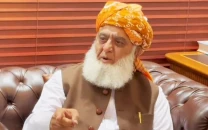MUET postgraduate claims to have improved retinal scan technology
Over 500 students conferred degrees at a convocation on Monday.

The research is a big advancement over earlier eye-screening technologies, most of which scanned the iris, the thin circular structure in the eye that controls the diameter and size of the pupil. PHOTO: FILE
This new technology improves upon existing retinal scanning systems, which recognise optic discs, fovea and blood vessels that are being used around the world. His doctoral thesis was titled “Study and analysis of uniqueness of vascular patterns in defining biometrics”.
Dr Ghazanfarullah revealed his discovery at MUET’s 15th convocation ceremony on Monday. A total of 517 undergraduate and seven doctorate degrees were conferred.
The application of biometric scanning in Pakistan is still at an early stage, with finger printing technology continuing to be the primary identification marker used by the government and private enterprises. Computerised national identity cards, the primary form of identification issued by the Pakistani government to its citizens, continues to make use of finger printing technology.
Explaining his hypothesis, Dr Ghazanfarullah claimed that his research focused on patterns of blood vessels in the eye, which are not affected by ageing. The research is a big advancement over earlier eye-screening technologies, most of which scanned the iris, the thin circular structure in the eye that controls the diameter and size of the pupil. “The forging of eye features, as we see in Hollywood movies, would no longer be possible through retinal screening,” claimed Ghazanfarullah.

The MUET graduate claimed that the technology could be used by the defence, banking and healthcare sectors of the country. He added that the scanners that make use of the technology could be imported for about $5,000, while “some easily available software can be used to control them”.
The university seemed to be on track to meet HEC’s criterion for universities to have assistant professors with doctorate degrees, as 38 of its 104 faculty members now meet the requirement.
Some of the areas where the university awarded doctorate degrees on Monday included bioengineering, telecommunication, textile, mechanical and civil engineering, and mathematics. The university conferred 44 masters and 347 degrees in engineering, as well as 27 undergraduate degrees in architecture, and 30 in business technology. Anam Ali Memon, Sara Qadeer and Sanjay Kumar topped in their respective faculties. A total of 10 gold medals and 25 silver medals were awarded on the occasion.
HEC chairman Dr Javed Laghari, who was the chief guest, expressed his hope that MUET rank among the top 100 engineering universities in the world within the next two years. MUET vice chancellor Dr Abdul Qadeer Rajput said that the varsity was hoping to introduce a range of research initiatives.
Published in The Express Tribune, January 22nd, 2013.



















COMMENTS
Comments are moderated and generally will be posted if they are on-topic and not abusive.
For more information, please see our Comments FAQ